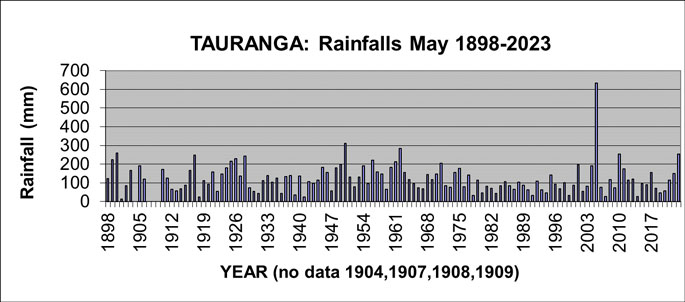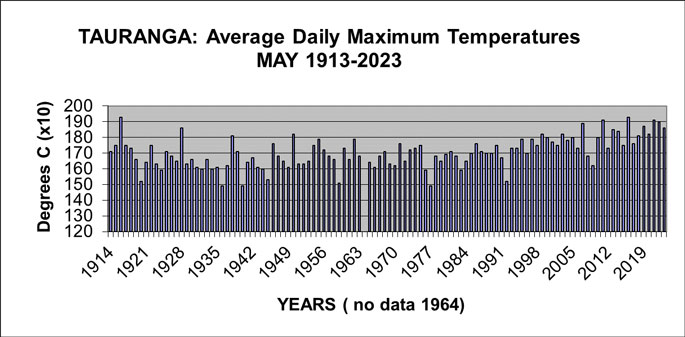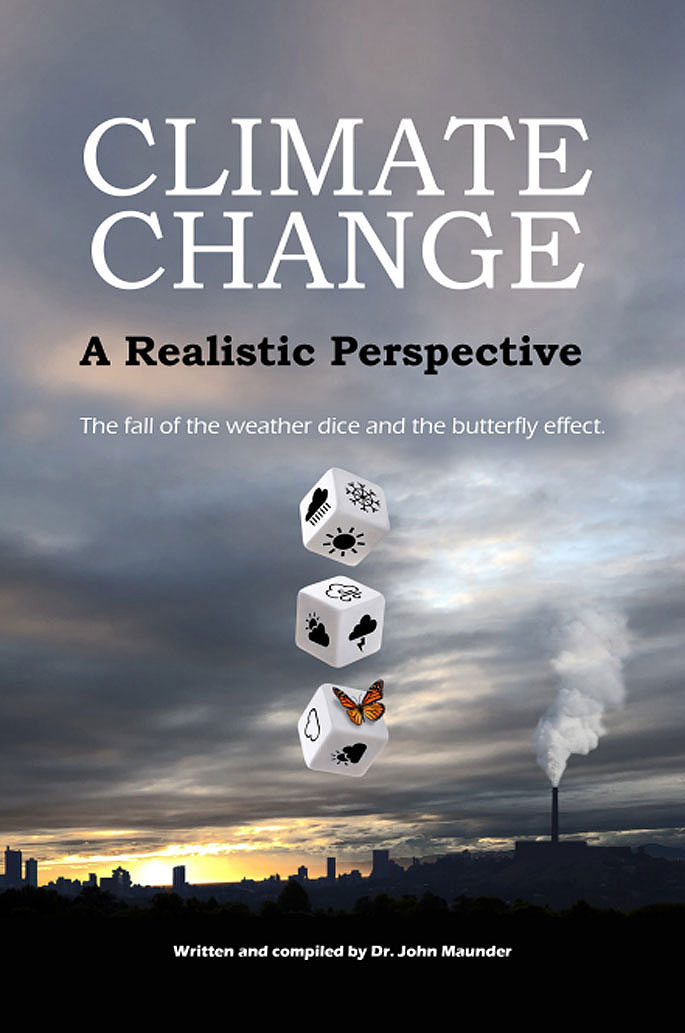 |
Weather Eye with John Maunder |
May Rainfalls 1898-2023
Rainfalls for the month of May have been recorded in Tauranga since 1898 – except for 1904, 1907, 1908, and 1909.
The graph shows the range of rainfalls from an extreme high of 634 mm in 2005 to a low of 13 mm in 2001. The rainfall for May 2023 was 254 mm.
The second wettest May was 1950, when 311 mm was recorded, and the second driest May was in 1918, when only 24 mm fell. The long-term average rainfall for Tauranga for May is 124 mm.
Apart from the exceptional rainfall of 634 mm in May 2005, the graph shows a small decrease in overall May rainfalls when the last two 50-year periods are compared.

From January 1898 to December 1904, the observation site was described as the Tauranga Harbour, from November 1904 to April 1907 the site was described as simply ‘Tauranga'. From January 1910 to December 1923 the site was Waikareao, in Otumoetai; from January 1924 to September 1940 the site was at 148 Waihi Rd, in Judea; from October 1940 to January 1941 the site was at Te Puna; and from February 1941 to now, the site is Tauranga Airport.
The methodology used in adjusting the older sites to the current observing site was published in the NZ Meteorological Service Miscellaneous Publication No 180 in 1984. It is considered that the homogeneous rainfall series described here is a fair and true record of what the rainfall would have been if the current observation site (Tauranga Airport) had been used since 1898.
This should be coupled with the understanding that although standard accepted methodologies have been used, any adjustments are only estimates of what would have occurred if the location of the rainfall records had always been in the same place with the same surroundings and the same or similar recording gauge.
Since 1898, there have been 15 May months with a rainfall of 200 mm or more. In chronological order, the wettest May months are: 1899, 1900, 1917, 1925, 1926, 1928, 1949, 1950, 1956, 1961, 1962, 1971, 2005, 2010, and 2023.
In terms of dry May months, there have been only nine May months with rainfall of less than 40 mm. In chronological order, the driest May months are: 1901, 1918, 1939, 1941, 1978, 1991, 1999, 2007, and 2014.
Of particular significance is the exceptional rainfall in May 2005. I estimated that such a rainfall is likely to occur in Tauranga only about twice in every 1000 years. This suggests that the government, at that time, could have had a much more important role in the financial implications of the floods, which affected many areas of Tauranga in May 2005.
*********************************************
Average May afternoon temperatures 1913-2023
The average afternoon temperature in Tauranga in May 2023 was 18.6 degrees C.
Temperatures have been recorded in the Tauranga area at several sites during the last 109 years, including the current Tauranga Airport site from June 1990.
It's very common for areas, such as Tauranga, to have experienced different observation sites during the years – and the readings from the earlier sites have been adjusted to the present site using standard climatological procedures.
It's considered the temperature series described here is a fair and true record of what the temperature would have been if the current observation site (of Tauranga Airport) had been used throughout the period.
Traditionally, temperature observations have been recorded with a set of maximum and minimum temperature thermometers.
These record the daily maximum temperature – usually recorded in mid-afternoon – and daily minimum temperature – usually recorded just before dawn.
This analysis of temperatures for Tauranga is for the average daily maximum temperatures.
The graph shows details of the average daily maximum temperatures, called simply ‘afternoon', for Tauranga for May from 1913-2021. May 1964 is not included because of incomplete data.

The long-term average afternoon temperature in May for Tauranga is 16.9 degrees Celsius, ranging from the cool May months of 1936, 1940, and 1997 with an average afternoon temperature of 14.9 degrees Celsius, to the warm May months of 1916 and 2016 both with an average afternoon temperature of 19.3 degrees Celsius, May 2011 and May 2021 with 19.1 degrees Celsius.
The graph of the average afternoon temperatures for May shows generally increased temperatures during the last 25 May months.
From 1913 to 2022, there have been 19 May months with an average afternoon temperature of 18 degrees Celsius or more, and 11 May months with an average afternoon temperature of less than 16 degrees Celsius.
The 18 warmest May months, in terms of afternoon temperatures, on record in chronological order are: 1916, 1928, 1938, 1950, 1999, 2000, 2003, 2005, 2007, 2010, 2011, 2013, 2014, 2016, 2018, 2019, 2020, 2021,2022 and 2023.
In contrast, the 11 coolest May months, in terms of afternoon temperatures, on record in chronological order are: 1913, 1920, 1924, 1936, 1940, 1945, 1959, 1967, 1977, 1983, and 1992.
The average afternoon temperature in May during the 49-year period 1914-1962 was 16.7 degrees Celsius, compared with 17.1 degrees Celsius for the 49-year period from 1963-2011.
***************************************
For further information on a range of weather and climate matters see my recent book "Climate Change: A Realistic Persepective.. the fall of the weather dice and the butterfly effect" . Available from Amazon.au.


